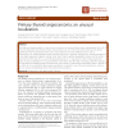In search for evidence: combining ad hoc survey, monitoring, and modeling to estimate the potential and actual impact of ground level ozone on forests in Trentino (Northern Italy).
Schlüsselwörter
Abstrakt
A 5-year project was carried out over the period 2007-2011 to estimate the potential and actual ozone effect on forests in Trentino, Northern Italy (6207 km2) (Ozone EFFORT). The objective was to provide explicit answers to three main questions: (i) is there a potential risk placed by ozone to vegetation? (ii) are there specific ozone symptoms on vegetation, and are they related to ozone levels? (iii) are there ozone-related effects on forest health and growth? Different methods and techniques were adopted as follows: monitoring ozone levels, ad hoc field survey for symptoms on vegetation and chlorophyll-related measurements, modeling to upscale ozone measurements, ozone flux estimation, statistical analysis, and modeling to detect whether a significant effect attributable to ozone exists. Ozone effects were assessed on an ad hoc-introduced bioindicator, on spontaneous woody species, and on forest trees. As for question (i), the different ozone-risk critical levels for both exposure and stomatal flux were largely exceeded in Trentino, evidencing a potentially critical situation for vegetation. As for question (ii), specific ozone foliar symptoms related to ozone exposure levels were observed on the introduced supersensitive Nicotiana tabacum L. cv Bel-W3 and on the spontaneous, ozone-sensitive Viburnum lantana L., but not on other 33 species surveyed in the field studies. Regarding question (iii), statistical analyses on forest health (in terms of defoliation) and growth (in terms of basal area increment) measured at 15 forest monitoring plots and tree rings (at one site) revealed no significant relationship with ozone exposure and flux. Instead, a set of factors related to biotic and abiotic causes, foliar nutrients, age, and site were identified as the main drivers of forest health and growth. In conclusion, while ozone levels and fluxes in the investigated region were much higher than current critical levels, evidence of impact on vegetation-and on forest trees in particular-was limited.


